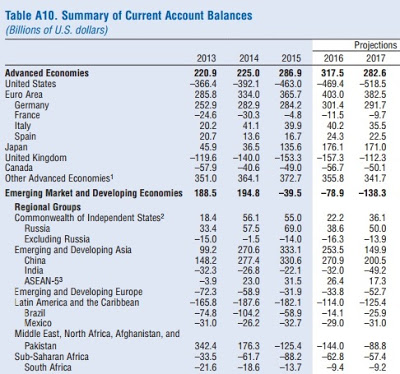
For the world as as a whole, exports need to equal imports. Thus, the large US trade deficits are necessarily offset, out there in the world economy, by equally large trade surpluses in other countries. From a global perspective, these offsetting surpluses are largely in three countries: China, Germany, and Japan.
Here’s are some statistics from the IMF last October showing trade balances around the world. The US trade deficits are near the top. Two lines lower, you can see the large German trade surpluses. Four lines below that are the large trade surpluses for Japan. Further down, under the category of “Emerging and Developing Asia,” are the trade surpluses for China. Of these three, China had the biggest trade surplus in 2015, but Germany’s trade surplus was larger in 2016 and is projected by the IMF to be much larger in 2017.

For some additional perspective on trade surpluses in these countries, here are a couple of figures using OECD data.
This figure shows trade surpluses over time from 2000 through the third quarter of 2016. (The data is quarterly, so you would need to add it up to get the annual numbers). The red line spiking high in the middle of the figure shows China’s trade surpluses, which were near-zero in the early 2000s before taking off, and are now slightly below German levels. The purple line shows Japan’s trade surpluses, including that intriguing moment in 2014 when Japan ran a trade deficit for a quarter. The blue line shows Germany’s trade surpluses, which start off as trade deficits back around 2000 and have climbed since then.

China’s economy is much larger than Germany’s. So given that their trade surpluses are roughly similar in absolute size, Germany’s trade surplus will be a much larger share of it
Here is the same trade data expressed as a share of GDP. Germany’s trade surpluses are now up to about 8% of GDP. As a share of GDP, Japan’s trade surpluses are larger than those of China.
















